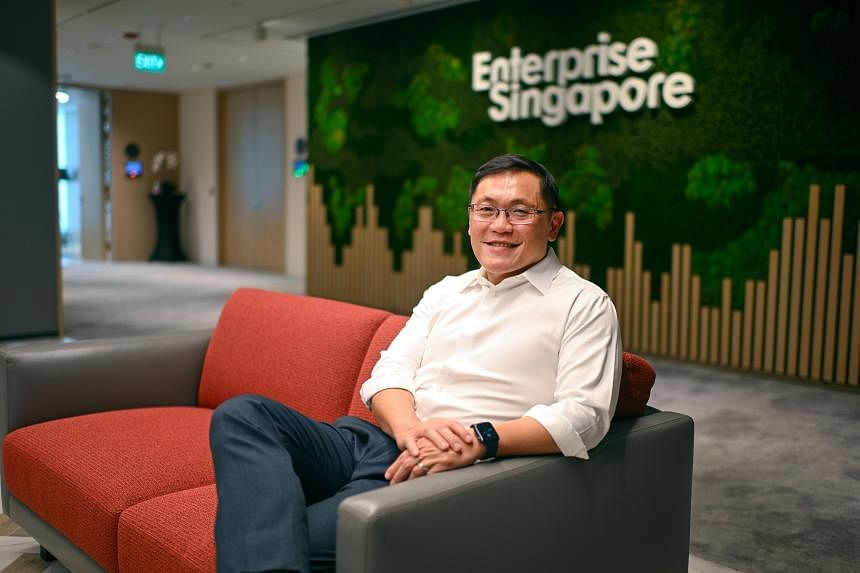SINGAPORE – Renewable energy and healthcare are two new areas of growth where Singapore can harness its strengths to compete in an international arena.
Specifically, offshore wind and precision medicine are the sectors where the Republic can maximise opportunities and contribute to its long-term growth, said Enterprise Singapore’s (EnterpriseSG) new chairman Lee Chuan Teck.
Mr Lee, the former chief executive of EnterpriseSG, succeeded Mr Peter Ong, a long-time civil servant who spent more than 30 years in the public sector. EnterpriseSG also changed its leadership model such that it no longer has a CEO, but an executive chairman and managing director.
Mr Lee, who assumed his new role on April 1, outlined the strategy for the country to achieve 2 per cent to 3 per cent growth on average each year over the next decade, which Deputy Prime Minister Lawrence Wong mentioned during his Budget 2024 speech in February.
For EnterpriseSG, this means offshore wind and precision medicine are the areas to be in as they are external-facing sectors with growth potential, even as it focuses on increasing productivity for internal-facing sectors like retail and logistics.
It also means finding a new way to engage companies along their transformation journey, he added.
“The economic environment is becoming more challenging. Externally, you see the world is becoming less open and more contested. Within Singapore, we are a mature economy and operating at very close to full capacity,” Mr Lee said.
Hence, to achieve the growth that is desired, Singapore has to take a “bolder, more transformational approach” to economic and enterprise development.
He noted that this spirit of transformation is already seeded across industries through various Industry Transformation Maps, which are road maps developed for 23 industries to guide their growth.
But more has to be done, Mr Lee said. In the external-facing sectors, this means maximising growth, especially as these companies have more opportunities, but also face more competitive pressures.
Some of these companies are in more established, mature sectors, but they remain highly competitive and generate growth in the near term, he noted. For example, port operator PSA has grown its network and now has global integrated supply chain, transportation and logistics solution capabilities.
Other companies are in more nascent sectors that may not generate immediate dividends in the next few years, but have very strong growth potential beyond the next five to 10 years, he said.
“It really boils down to answering two questions – what the world needs and what Singapore can do to address these needs,” Mr Lee added. “The world needs cleaner energy to continue to maintain our lifestyles without warming up... The world needs to provide an affordable and effective way to give medical treatment to an ageing population going forward. What can we provide?”
He noted that Singapore has good companies from years of research and development that can cater to those needs.
For instance, precision medicine – which guides the best diagnostics and therapeutics for each individual – can be a new engine of growth, especially since the Republic already has a fairly deep and vibrant bio life sciences ecosystem, Mr Lee said.
The industry had a global market size of US$75 billion (S$101 billion) in 2023, and is projected to grow at an average rate of 9.1 per cent per year up to 2032.
But he added that Singapore has more to do, as it has been challenging for products to go from various funding series or growth stages to commercialisation, and EnterpriseSG can help to bridge that last mile.
The agency has helped to connect companies to healthcare providers in America, Europe and, increasingly, Asia. Some start-ups have partnered with firms that can help them put their products through clinical trials and eventually get approval for distribution in America.
“Given the potential there is in our ecosystem, and with the extra data and support that we’re providing them... one day, we may have our own Moderna and BioNTech (referring to the Covid-19 vaccines). We don’t have them today, but who’s to say we won’t have them in the future?” Mr Lee said.
Besides healthcare, the world also needs to transition gradually from fossil fuels to renewable energy. Hence, Singapore can also make moves in areas like offshore wind.
Local firms from Sembcorp and Seatrium to small and medium-sized enterprises like Mooreast have projects in green power generation in areas as far afield as Scotland. In Asia, there is also potential in places like Vietnam, Malaysia, Japan and Taiwan, Mr Lee noted.
But the domestic sector also needs to become more efficient, especially as firms grapple with high business costs and a resource-limited environment.
Mr Lee said: “In the next lap going forward, if we want to achieve DPM Wong’s ambitious growth targets, I think we must be prepared to experiment and try new and more radical solutions.”
These solutions involve aggregating demand and even supply chains, so small firms can get better pricing for their products, while lowering the costs of their logistics.
Mr Lee noted that in retail, the productivity of a chain store is about three to 3½ times that of a micro store because a chain will have economies of scale.
The Industry Transformation Maps have lifted the productivity of individual companies, but the next leg of growth will have to be at the industry and sectoral level to pull resources together so companies have the scale, he said.
EnterpriseSG wants to build better engagement with companies. Mr Lee added that it works with about 20,000 companies annually, but mostly when they apply for grants. He said these form only a fraction of the 240,000 local companies here.
He added: “Going forward, we need to think about how we can engage all of them, or at least most of them across their whole entire lifespan... And so we are looking to build a new digital platform that can interface with every single enterprise out there.”
Besides grants, the new platform should also suggest personalised ideas and tools for each company, such as if a new technology or trade agreement applies to the market that the firm is in.
“We’re going to change the way we interact with enterprises completely. Of course, such a platform is a mammoth undertaking, and we are not going to get it ready overnight. It’s going to take several years to build but we need to start on that journey,” he said.
Ultimately, Mr Lee noted that DPM Wong’s growth targets are very ambitious, and not easy for firms. “But I think it’s very worthwhile because if we can show to the world that Singapore, being a mature economy with limited resources, can still maintain that degree of vibrancy, then we’ll be able to attract more foreign investments and in turn create good jobs for the generations to come,” he added.


